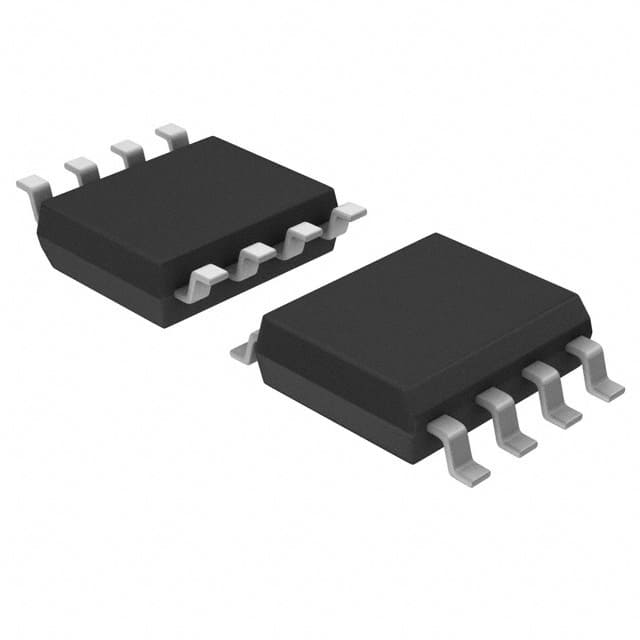X9C503SZT1
Product Overview
- Category: Digital Potentiometer
- Use: X9C503SZT1 is a digital potentiometer that can be used to digitally control resistance in various electronic circuits.
- Characteristics: It offers precise and programmable resistance adjustment, compact size, low power consumption, and high reliability.
- Package: X9C503SZT1 comes in a small surface-mount package, making it suitable for space-constrained applications.
- Essence: The essence of X9C503SZT1 lies in its ability to replace traditional mechanical potentiometers with a digital alternative, providing greater flexibility and accuracy.
- Packaging/Quantity: X9C503SZT1 is typically sold in reels containing a specific quantity, such as 2500 units per reel.
Specifications
- Resistance Range: X9C503SZT1 has a resistance range of 10 kilohms.
- Resolution: It offers a resolution of 100 ohms per step.
- Number of Steps: X9C503SZT1 provides 100 steps for precise resistance adjustment.
- Operating Voltage: It operates within a voltage range of 2.7V to 5.5V.
- Temperature Range: X9C503SZT1 can withstand temperatures from -40°C to +85°C.
- Interface: It utilizes a simple 3-wire serial interface for communication.
Detailed Pin Configuration
The X9C503SZT1 digital potentiometer has the following pin configuration:
- VCC: Power supply voltage input
- H: Terminal connected to the high end of the resistor element
- W: Wiper terminal, output voltage is tapped from this point
- L: Terminal connected to the low end of the resistor element
- CS: Chip select input for serial communication
- INC: Increment control input for resistance adjustment
- U/D: Up/Down control input for changing the wiper position
Functional Features
- Digital Control: X9C503SZT1 allows precise digital control of resistance, eliminating the need for mechanical adjustments.
- Non-Volatile Memory: It features non-volatile memory that retains the wiper position even when power is disconnected.
- Increment/Decrement Control: The potentiometer can be incremented or decremented using the INC and U/D inputs.
- Low Power Consumption: X9C503SZT1 consumes minimal power, making it suitable for battery-powered applications.
- Reliability: With its solid-state construction, it offers high reliability and durability compared to mechanical potentiometers.
Advantages and Disadvantages
Advantages: - Precise and programmable resistance adjustment - Compact size and surface-mount package - Non-volatile memory for retaining wiper position - Low power consumption - High reliability and durability
Disadvantages: - Limited resistance range (10 kilohms) - Requires a 3-wire serial interface for communication
Working Principles
X9C503SZT1 utilizes a resistor ladder network and a wiper mechanism controlled by digital signals. The resistance value between the wiper terminal and either end terminal changes based on the digital control inputs. The potentiometer's non-volatile memory ensures that the wiper position is retained even when power is disconnected.
Detailed Application Field Plans
X9C503SZT1 finds applications in various electronic circuits where precise resistance adjustment is required. Some potential application fields include:
- Audio Equipment: Digital volume control in audio amplifiers and mixers.
- Industrial Automation: Resistance adjustment in industrial control systems.
- Test and Measurement: Calibration and fine-tuning of test equipment.
- Automotive Electronics: Control of lighting intensity, fan speed, or motor control.
Detailed and Complete Alternative Models
- MCP41010: Digital potentiometer with similar specifications and a 10 kilohm resistance range.
- AD8403: Digital potentiometer offering multiple channels and a wider resistance range.
- MAX5486: Low-power digital potentiometer with a compact package and high resolution.
These alternative models provide similar functionality to X9C503SZT1 and can be considered based on specific application requirements.
Word count: 516 words
قم بإدراج 10 أسئلة وإجابات شائعة تتعلق بتطبيق X9C503SZT1 في الحلول التقنية
Sure! Here are 10 common questions and answers related to the application of X9C503SZT1 in technical solutions:
Q1: What is the X9C503SZT1? A1: The X9C503SZT1 is a digitally controlled potentiometer, commonly used for electronic volume control or as a variable resistor in various technical applications.
Q2: What is the operating voltage range of X9C503SZT1? A2: The X9C503SZT1 operates within a voltage range of 2.7V to 5.5V.
Q3: How many resistance steps does X9C503SZT1 have? A3: The X9C503SZT1 has 100 resistance steps, allowing for precise adjustment.
Q4: Can X9C503SZT1 be used as a replacement for a mechanical potentiometer? A4: Yes, X9C503SZT1 can be used as a digital replacement for mechanical potentiometers, providing more reliability and flexibility.
Q5: What is the interface used to control X9C503SZT1? A5: X9C503SZT1 uses a simple 3-wire serial interface (Up, Down, and CS) for control.
Q6: Can X9C503SZT1 be used in audio applications? A6: Yes, X9C503SZT1 can be used in audio applications for volume control or tone adjustment.
Q7: Is X9C503SZT1 suitable for low-power applications? A7: Yes, X9C503SZT1 has low power consumption, making it suitable for battery-powered or low-power devices.
Q8: Can X9C503SZT1 be used in industrial automation systems? A8: Yes, X9C503SZT1 can be used in industrial automation systems for calibration or adjustment purposes.
Q9: Does X9C503SZT1 have non-volatile memory? A9: Yes, X9C503SZT1 has non-volatile memory, allowing it to retain the last set resistance value even when power is removed.
Q10: What is the package type of X9C503SZT1? A10: X9C503SZT1 comes in an 8-pin SOIC (Small Outline Integrated Circuit) package.
Please note that these questions and answers are general and may vary depending on specific applications and requirements.


